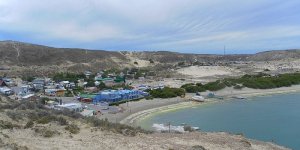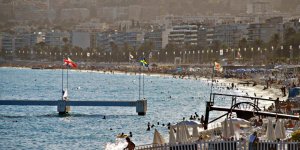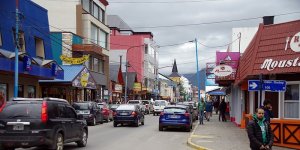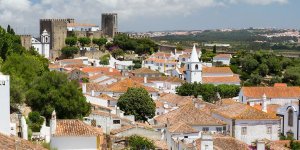| Published in Destinations |
Ladakh, India
Ladakh is a mountainous region in northeast Jammu and Kashmir in north India and in the area known as the Trans-Himalaya. Most of the tourist attractions are in the east and directly related to Tibetan Buddhist culture.
The largest town is Leh, followed by Kargil. Ladakh is subdivided into two districts, which are named after the two towns. Kargil District is in the west and consists of Drass, famed as the second-coldest inhabited place on the earth with recorded temperatures of -56 °C or -69 °F, Suru, Chiktan and Batalik-Garkon. Leh District is the eastern part of Ladakh.
One branch of the ancient Silk Road ran through Ladakh and was a fairly important trade route at one time, for example when Marco Polo crossed it. A pass leads north from Leh to Khotan in what is now Xinjiang. From Leh there are several routes south; the main one involved following the Indus down to Srinagar, and in antiquity to Taxila.
The Indus valley is the Ladakhi heartland, with the highest population density, and large amounts of agricultural land. Running parallel with it, roughly north-east south-west, are a series of valleys and mountain ranges. North of the Indus valley is the Ladakh range, on the other side of which is the Shayok, and Nubra valleys. South of the Indus is the Stok range, clearly visible from Leh.
On the other side is the Markha valley is a popular trekking destination. Farther south-west is a series of minor ranges and uninhabited valleys before we come to Zangskar. The Kargyak and the Stod rivers join at Padum, to form the Zangskar river which bucks the trend and flows north through a narrow gorge to join the Indus. To the south of Zangskar is the Grand Himal range marking the southern limit of Ladakh.
To the east of this series of ranges is the Changtang, a high plateau home to nomads. It is known as Kharnak in the west, Samad Rokchen in the north east and Korzok in the south east. Not a true plateau, it has a chaotic assortment of minor mountains ranges not much higher than the wide valleys between them. With no drainage leading out of this area, there are a number of beautiful salt water lakes that make popular destinations for tourists.
Cities
• Leh — a medium-sized town, very picturesque, an excellent base for exploring Ladakh, good guest houses and restaurants.
• Alchi — a small village with a gompa or Buddhist monastic complex, 4 km off the road between Kargil and Leh.
• Kargil — key for access to Zanskar area, and a necessary stop on the way from Leh to Srinagar and the Vale of Kashmir.
• Lamayuru — a small village with a Buddhist gompa, on the road between Kargil and Leh.
• Shey — located near Leh, was the capital of Ladakh until Leh took its place.
Other destinations
• Nubra Valley - The fertile Valley of Nubra formed a part of the overland route between Tibet and Turkestan, prior to the partition of British India, and even until the Indian/Chinese war of 1967. Once dotted with garlands of camel and yak caravans, this Silk Route is also known as the 'Valley of Flowers' of Ladakh, and is amongst the greenest valleys in the region, you may also be able to spot feral camels, descendants of the caravan trade.
Along the eastern edge of Karakoram Range lies Nubra Valley, at an altitude of around 10,000 ft above sea level. Situated along the ancient caravan route of Central Asia, enigmatic Nubra Valley can be reached only by road through Khardung La (18,380 ft), the highest motorable road in the world.
Khalsar along the Khardung Pass is the point where two roads bifurcate, one leading to Diskit and Hunder while the other one reaching the town of Sumur and Panamik. This high-altitude Ladakh valley unfolds a bizarre blend of landscapes, with gushing rivers, flowers orchards, desert sand dunes and green fields.
Open to tourists since 1994, Nubra Valley draws adventure enthusiasts from all corners of the globe. Nubra means Ldumra or the Valley of Flowers. True to its name, Nubra is covered with colourful roses and beautiful lavender bushes throughout the warmer months.
Quaint villages and Buddhist monasteries against the beautiful backdrop of snow-clad peaks add charm to this valley of contrasts. Since Nubra is close to the borders of Pakistan and China, an Inner Line Permit is required before visiting the valley.
• Zanskar - one of the remotest regions of the Ladakh. Zanskar is spread over an area of about 300km², which is only accessible through high passes. This valley is higher than any other valley in the Ladakh region and located in the inner Himalaya. Rainfall is very low and the climate is very harsh.
Get in
Buses run directly to Leh from either Manali or Srinagar. En route to Leh one can stop in a number of places; most will get off in Keylong, the administrative centre for Lahaul. Overlooking Keylong is the Kardang monastery. This is a popular choice due to the tense security situation in Kashmir; however, the road is open only from June to mid October, due to snowfall.
There are shared taxis from Manali which start early in the morning and reach Leh early next morning. Tourist buses from HPTDC and the local HRTC buses stop overnight in Keylong. There are also minibuses and shared taxis that make an overnight stop in Sarchu - this comes with a high incidence of altitude sickness, since Sarchu (also dubbed "The Vomit Hilton") lies more than 700 m higher than Leh, at 4,253 m.
Coming from Srinagar there are a few interesting places to stop en route: Kargil at 2,693 m (where the buses stops, the best choice for altitude acclimatization), Lamayuru and Alchi (that also offer accommodation). The opening and final closing of both roads, but no major events in between, are announced on the official Leh website. Srinagar-Leh news updates are found here, and Manali-Leh here.
Daily flights to Leh are operated by Indian and Jet Airways from Delhi, Srinagar, Jammu and elsewhere. These are, however, subject to inclement weather and may be cancelled at any time, so keep your schedule flexible. Altitude sickness is also a worry.
You can ride to Leh by motorcycle between June and mid-October (when the roads are open). Bikers usually follow either of the 2 routes:
• Delhi - Ambala - Jalandhar - Patni Top - Srinagar - Kargil - Leh
• Delhi - Chandigarh - Manali - Sarchu - Pang - Leh
Get around
By bus
Ladakhi buses run from Leh to the surrounding villages. They are often overcrowded and generally disorganised and poorly run. Daily buses or mini buses run to Alchi, Basgo, Dha-Hanu, Likir, Nimmu, and Saspul; twice daily to Chemray, Hemis, Matho, Stok, and Tak Tok; hourly or more often to Choglamsar, Phyang, Shey, Spituk, Stakna, Thiksay.
By taxi
There are a number of local taxis, that will take you to the surrounding monasteries much faster and more comfortably than Public transport. Rates are fairly steep compared to elsewhere in India.
By truck
Trucks often stop for hitchhikers, who are usually expected to pay half the bus fare, bargaining may be necessary. They are slower than the buses and sometimes stop for long periods to unload cargo.
By motorcycle
In Leh there are a number of shops that will rent motorbikes, mostly the Royal Enfield, still made in India today (350 and 500 cc model). Rentals are fairly cheap, and can be good way to travel around and far cheaper than local taxis. Check your rented bike before you leave so that you don't find yourself stranded in the middle of nowhere.
Things to note
In most sections of the journey, the roads are in a bad condition, but in certain conditions the roads are literally non-existent. However, the Border Roads Organisation (BRO) has done a good job, with whatever little resources that are available, in making the difficult terrain accessible to vehicular traffic.
Though there are many mechanics in Leh who deal with many bikes, the availability of spares is limited. So before leaving be sure to get your bike serviced (get all cables checked/ changed, set chain, get oil topped up, brakes inspected etc.) and also carry all necessary spares (cables, chain link, bulbs etc.)
Make sure to carry the originals of all your bike's documents.
Glaciers tend to melt as the day progresses and flow across roads at some places. Be sure to plan to reach and cross these glacier melts, commonly known as Nalas (for example Pagal nala, Khooni nala, Whisky nala, Brandy nala etc.), during the earlier part of the day, when the flow is low and the depth of the water is still easily passable.
When you encounter a military convoy, always pull over and let them pass. It might be a good idea to find out from the locals as to when the convoy goes uphill and downhill and try to time your trip accordingly.
By bicycle
The scenery is magnificent viewed at the pace of a bicycle, however one would need to be well prepared with full camping equipment. There is a bit less than 1,000 km of paved roads in Ladakh. The Manali-Leh-Srinagar road makes up about half of that and the remainder are spurs off it.
As such it's not possible to string together a loop, and the only route that would avoid backtracking would be to follow the Manali-Leh-Srinagar road. You would need to check the current situation and think carefully. You may decide that travelling in Kashmir at bicycle pace is more of a risk than you want to take.
In addition to the paved roads there are some trekking routes that are possible to ride a lightly loaded, sturdy mountain bike on, perhaps hiring a horse and handler to take your baggage. Padam to Darcha, via Shingo La (pass) would be a good route for this, though you would still need to push your bike over the pass itself. Ask trekkers in Ladakh for more options.
By foot
For the traveler with a number of months it is possible to trek from one end of Ladakh to the other, or even from places in Himachal Pradesh. The large number of trails and the limited number of roads allows you to string together routes that have road access often enough to restock supplies, but almost entirely avoid walking on motor roads. See below in the Do section for more info.
Note
If you plan to drive/ ride in to the Ladakh region in your own car/ bike:
— Carry enough spares and all the required tools.
— Try to learn basic vehicle maintenance before you start on the trip.
— Carry spare fuel. (There is a 380 km stretch on the Leh–Manali highway that has no petrol pumps.)
— You will need to get permits to visit certain places (for example, Khardung La).
What to See in Ladakh
Many places in Ladakh need an Inner Line Permit which is available for free in DC's office in Ladakh. A travel agent can also arrange the permit for INR100 per person within an hour on any working day.
The main tourist sites relate to Tibetan Buddhism, mainly gompas (Buddhist monasteries), and to the stunning landscape.
Ladakh is not only home to some of the most beautiful and serene monasteries you'll ever see, but it also a land of rich natural beauty: and it's this natural beauty that is impressive because it's a barren beauty. Many find themselves at loss to understand how something so barren can yet be so beautiful. Be respectful, these are holy places with monks in most of them.
Many of the monasteries in the area can be visited from Leh, including the Hemis monastery which is the largest monastery of Ladakh with at least 150 lamas. Also, many of the villages in the area are worth a visit, including some close to Leh and some in Nubra Valley or Zanskar.
Popular landscapes include the Moon-land-view in the area around Lamayuru on the Leh-Kargil highway, and Pangong Tso which is a 64 m long lake of an attractive colour
Itineraries
There are some regular tourist circuits which entail driving 200-400 km roundtrip out of Ladakh. One needs to acclimatize to the attitude in Leh (3,500 m) before heading out as AMS (acute mountain sickness or altitude sickness) can ruin the entire trip.
• Kang Yatse. This trek is located to the south east part of the Leh, in the Markha valley.
• Leh-Karu-Chang La-Tangtse-Pangong Tso & Back. This is a popular trip to Pangong Tso Lake and can be done by taxi/bike. Most people do it as a day trip starting early in the morning and come back by the evening. However, there are arrangements for stay near the lake in Lukung & Spangmik and one can stay overnight to enjoy this place at a slower pace. Camping is also possible.
• Leh-Khardung La-Nubra Valley (Valley of Flowers). This is another popular trip but difficult to do in one day. Nubra Valley may not be as beautiful as is touted to be, and is second favourite to tourists as a trip from Leh. Some people return from Khardung La (5,600 m), which is claimed to be the highest motorable pass in the world. It provides excellent views of Ladakh Range as well as Karakoram Range on the other side. Accommodation is available along the way and in Nubra Valley at various places.
• Leh-Lamayuru-Leh. This is an easier drive along Indus river towards Kargil and one can also see the confluence of Indus and Zanskar on the way. Lamayuru is a beautiful place and is home to the oldest monastery and one of the most important in Ladakh. One can stay in the monastery or in the surrounding village.
• Leh-Upshi-Tso Kar-Tso Moriri. This is another trip which covers two smaller lakes Tso Kar and Tso Moriri. There is accommodation available in Korzok (Tso Moriri), but camping near the lake is not allowed.
• Parang La Trek. This is one of the most challenging and adventurous trekking trails. This trek is located on an isolated route far into the mountains with many rivers to be crossed.
• Various monasteries around Leh. There are 4 or 5 big monasteries around Leh and can be covered in one day. The most important are Thiksey, Hemis, Spituk, Stok and Shey.
What to Do in Ladakh
• Volunteer: There are numerous NGOs in Ladakh , mostly centred on Leh, many of which take foreigners as volunteers if you can commit to a stay of a few months.
• Festivals: In late June and early July, the whole Ladakh region comes alive with festivals. Some are held at the local cricket and polo club in Leh, while others are held at the monasteries. Reserve a place well in advance as they get very crowded. Some of the festivals are only held every 12 years, (such as one at Hemis) and at that time the monastery will display its greatest treasure, such as a huge thangka (a religious icon painted or embroidered on cloth).
Trekking
• Trek: Ladakh is an excellent trekking area for experienced trekkers. The infrastructure is nowhere near as developed as in Nepal, necessitating greater preparedness on the part of the trekker. Most trekkers go with a guide and some pack horses, which is easy to organise and, if arranged in Leh, quite affordable.
It is possible to trek independently but this should not be undertaken lightly and without much consultation with locals. People do go missing and die on these trails. Below are a few selected routes:
• The Baby Trek
Duration: 2-3 days.
Season: Year round.
Get In: The trail starts at Likir, there are a few buses from Leh daily.
Description Ladakh's one "tea house trek" is, despite the name, hard work due to the steep and frequent ascents and descents. Its highest point is 3,750 m (unusually low for Ladakh). It passes through frequent villages, allowing one to sleep in guest houses or peoples' homes every night. It is a good introduction to trekking in Ladakh and way to acclimatize to the altitude. The main attractions of this trek are the large villages filled with beautiful, well-made houses seated among good agricultural land. The mountains and views from the passes are relatively unimpressive.
Route: Likir village - Phobe La (3,580 m)- Sumdo village - Chagatse La (3,630 m) - Yangthang village - Tsermangchen La (3,750 m) - Hemis Shukpachen village - Mebtak La (3,720 m) - Ang village - Tingmosgam village.
• The Markha Valley Trek: This trek is among the easily accessible and popular trek in Ladakh. This trek also features a large diversity of landscapes. Markha Valley is surrounded by the mountain Kangyatse, which at its highest has a height of 6,400 m above the sea level. The trek passes through colourful villages and beautiful valleys where the trekker can experience and enjoy the tradition and culture of Leh Ladakh.
Maps
General travel maps showing the roads and tourist sites are commonly available in India and abroad.
The best quality trekking maps are nowhere near the quality of maps covering trekking areas of Europe or North America. Note that high-quality maps of the border regions of India/Pakistan/China are illegal in India for security reasons, and your map may be confiscated if you allow security personnel to see it (despite very high quality maps of Indian J&K and the LoC being available from the Survey of Pakistan in Islamabad).
• Survey of India produces a very out of date (early 1980s) trekking map of J&K; it's cheap, and could be useful for planning a route with an experienced guide.
• US Army Map Service. (1:250,000) - produces out-of-date (1950s and 60s) topographic maps of the whole of India, easily available on the Internet.
• Soviet Military Topographic Maps (1:200,000 & 1:100,000) - maps produced in the 1970s and 1980s which are now easily available on the internet but are expensive. They provide good information but all the labels are in Cyrillic script.
• Artou (1:300,000) - based on satellite imagery. In the early 2000s the best available, it is satisfactory for pre-trek route planning, but not good for navigation. A pirated print version has been available in Leh.
• Trekking Map of Ladakh by Sonam Tsetan (approx scale 1:600,000) is very accurate for what it shows: the trails, village names, and water courses. It lacks topography but has the most accurate place names of all the maps, making it a very useful planning tool. It's available in Leh for about INR200.
• Leomann (1:200,000) - may have better scale than the Artou, but it contains less information and is less accurate; however, the series does cover a lot more of Ladakh and elsewhere in the Himalayas.
• Ladakh Zanskar Trekking Map Series by Editions Olizane (1:150,000) is an excellent topographic map, with lots of detail.
Eat
Ladakhi food has much in common with Tibetan food, the most prominent foods being: Thukpa, noodle soup; and tsampa, known in Ladakhi as ngamphe, roasted barley flour, which is edible without cooking and therefore it makes useful, if dull, trekking food.
A dish that is strictly Ladakhi is skyu, a heavy pasta dish with root vegetables.
As Ladakh moves toward a less sustainable, cash-based economy, imported Indian foods are becoming more important. You are likely to be served rice and dal (lentils) with veggies even in villages without road access, and it's standard in Leh.
In Leh you can taste a wide range of cuisines, which include north Indian, Tibetan, Chinese, Italian and even Korean. Bakeries are plentiful in Leh. As in other heavily touristed areas of the Himalaya, they often claim to be German bakeries. They serve seasonal fruit pies, tarts, brownies and a variety of breads.
Drink
• Tea is traditionally made with strong black tea, butter and salt. It is mixed in a large churn and known as gurgur cha, due to the sound of mixing it. Similar to tea traditionally drunk elsewhere in Central Asia, it's more like soup than tea elsewhere; it can be refreshing and invigorating if you can get used to it. Sweet tea (cha ngarmo) is common now, made Indian style with lots of milk and sugar.
• Beer (chang) is traditionally made from barley; it has a yeasty taste slightly similar to sake.
Stay safe
• Ladakh is one of the safest parts of India, and the most basic precautions against petty theft are enough to keep you and your possessions safe. The locals are very friendly and humble.
• Most of the region is dotted with military cantonments every 50-80 km, but mainly because of its strategic position on international border between India and China. The army plays a major part in rescue and aid efforts, and that is why you will be required to produce identification documents or written permission from local authorities before entering some remote places.
• Leh is above 3,500 m (over 11,000 feet) and other parts of Ladakh are higher yet. There is risk of altitude sickness, especially for those who come from a lower altitude quickly, such as by flying in. (Wikivoyage)
See also Ladakh in Pictures
YOU MAY ALSO LIKE





 If you own or manage a travel-related business such as a hotel, a bed-and-breakfast, a restaurant, a pub or a cafeteria, you can create a web page for your business for free on Titi Tudorancea Travel Info. » |

